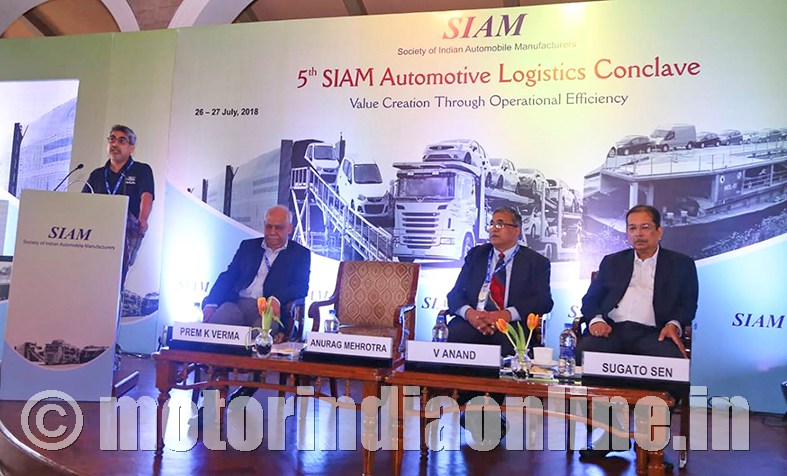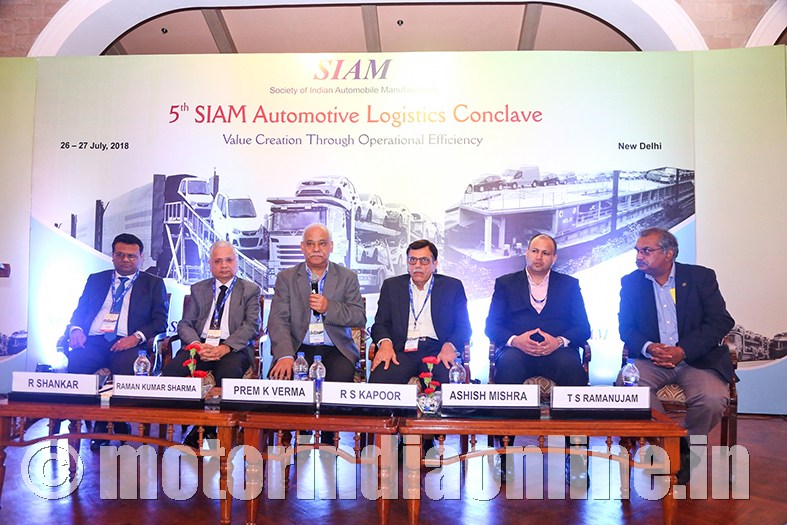The two-day convention discoursed on key bottlenecks and challenges plaguing the automotive logistics industry, and how these can be mitigated by building skilled manpower and embracing digitization and technology.

The automotive logistics in India is going through watershed moment at present, thanks to a series of factors and events starting from the demonetization impact and GST implementation last year to the latest ‘e-way’ bill mandate and staggering fuel prices till this day. With brighter prospects for the Indian automotive industry on the anvil, there is a need for auto logistics to recalibrate itself to the current ambience post GST and live up to those persistent challenges, including complexities and cost pressures, digital demand across the supply chain, lower skill sets, and absence of multi-modality in transportation.
Mr. Prem K. Verma, Chairman, SIAM Logistics Group, rightly set the tone for the event by acknowledging the need for the industry to instill skill development and efficiency in its system and cost to enhance the supply chain. “We have been going through challenging times with fluctuating fuel prices and lower skillsets”, he said, while adding that the current situation needs improvement.
It was pointed out that the automotive logistics in India is heavily dependent on road transportation (over 92 per cent) due to absence of viable multi-modal solutions, resulting in higher costs and transit time. Railways, on the other hand, accounts for around 4 per cent only, the reason being fractured handling infrastructure and higher transit time. Shipping continues to remain viable for exports only, while in-land and coastal shipping are still at nascent stages of development.
While deliberating on the way forward, Mr. Kalpesh Pathak, Vice-President, FIAT India, opined that the OEMs have to reorganize and redraft their supply chain and logistics management to cater to the upcoming challenges and market demands. In a similar vein, Mr. Anurag Mehrotra, MD, Ford India, called for automakers to collaborate with new logistics partners and go beyond the ‘unit cost reduction’ principle to achieve optimum efficiency and service delivery.

GST as an enabler
Reforming the traditionally fragmented tax structure, the GST has made it easier for vehicle manufacturers and parts suppliers to move freight across State borders and ensure uniform prices for goods right across the country. It is likely to bring substantial change to supply chains, as products can now be stored anywhere and distributed across State territories without duties. It must allow for more frequent order fulfilment and greater supply chain agility, while also reducing pressure on current storage facilities. It may also encourage the use of rail and waterborne transport, as supply chains increasingly consolidate vehicles for onward distribution over longer distances.
Yet, the challenges are close at hands and the industry is bearing impacts in terms of its operationalization. Mr. Prashanth Agarwal, Partner, PwC, brought out on the quintessential case of e-way bill introduction and how it is playing havoc due to lack of awareness, mistakes in data punching, and improper compliance of various partners across the supply chain.
“E-way bill generation has smoothened out, but that is not the only process. Logistics service providers face huge risks if there is improper compliance”, he said, pointing out that both OEMs and transporters have to have proper awareness of the requirements and technical know-how for effective compliance. He also agreed that a lot of scrutiny is expected from the government side on the operations and tax compliance in future, for which the auto logistics industry has to stand up to.
Speaking on value creation, Mr. Waman Parkhi, Partner, KPMG, argued that GST can actually bring in efficiencies. “Value is not created by chance. It is the result of multiple forces working together”, he said while identifying “GRIP” (GST, Regulatory, Infrastructure and Partnership) as creating value for each partner in the automotive value chain.
Adding further, Mr. Amit Kavathekar, Director, KPMG, opined that new tax credits, reduced bottlenecks, resource reorganization, and digitized management can bring in good efficiency in the processes, even for the upstream partners.
The speakers at the conclave also drew attention on the role of digitization and technology in improving efficiency. Last one year saw both OEMs and transporters adopting telematics and GPS, they agreed, while also acknowledging that many players are pro-active in embracing Electronic Proof of Delivery (EPOD) systems and concepts like ‘Control Tower’ (an information hub) and Batch for Billing.
Defining key trends in this regard, Mr. R. Shankar, CEO, TVS Logistics, said: “…seamless integration and electronically-connected logistics management using IoT sets the figures of merit for this industry”. He also noted that parcel or container level tracking is emerging globally, let alone vehicle level tracking.
The Vice President of Maruti Suzuki India, Mr. R.S. Kapoor, laid stress on ‘logistics innovation’ to improve economy. “There is a need to redefine monitoring systems in auto logistics, based on the parameters of productivity and efficiency, greener alternatives, and built-in safety operations”, he observed.
On the whole, the conclave agreed on “driving synergies through collaboration” in terms of multi-modal logistics, integration of systems, innovative partnerships, digitization, and skilling of manpower.
Conclave discusses driver crises in trucking industry
A panel discussion on day 2 of the conclave saw some critical dialogues on the driver shortage issue that is plaguing the road transportation in India, whose impacts are clearly realized in automotive logistics where more than 90 per cent of transportation happens by tractor-trailers.
Mr. R. Shankar of TVS Logistics, observed that the crisis is a socio-economic problem that involves certain social prejudice on the profession itself, which terribly impacts an individual’s life chances and personal aspects including his / her marriage life. “Improving the dignity of the profession and eliminating its uncertainties through economic upliftment and basic social security of those who take up driving can help”, he said.
On skilling and retaining existing drivers, Mr. Raman Kumar Sharma of ASDC stressed the need for a system that recognizes and certifies their skills. “A credible assessment system and commitment of logistics players to hire skilled people based on the assessment can standardize skilling in the industry”, he opined. Driver-relay model and attitudinal training can help retain them in the profession, he added.
In this regard, ASDC and the Logistics Sector Skill Council (LSSC) have joined hands for a proposal to establish driver training institutes in collaboration with State Governments. “They can impart key training on three aspects – road driving dynamics and safety, logistics activity and resource management, and technical maintenance”, revealed Capt. T.S. Ramanujam, CEO, LSSC.